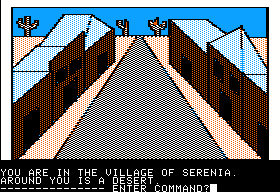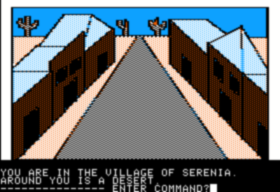Mystery House had been an experiment, done on the fly and on the cheap, to see whether there was enough money to be made in computer games to justify jumping in with both feet. Within days of the game’s release, the answer was plainly a resounding yes, and Ken and Roberta started working on systematizing the process and beginning a whole line of On-Line Systems “Hi-Res Adventures.” As Roberta sketched out a design — this time a more typical fantasy adventure, albeit one more inspired by fairy tales than Tolkien — Ken worked like mad to pull together a set of tools capable of implementing not just the next adventure but many more to come. Hackers love their tools, after all, and whatever his loyalty (or lack thereof) to the hacker ethic of elegant software as an idealistic end unto itself, Ken was no exception in this regard. Like Scott Adams before him, he coded a reusable adventuring engine, keeping the data that made up the new adventure separate from the interpreter that made it come alive — a move that would pay off in spades soon enough, when On-Line Systems began expanding its reach beyond the Apple II platform.
But most of all he devoted his attention to the thing that had made Mystery House stand out from its peers, its graphics. He and Roberta had been able to get away with the crude black-and-white sketches in that game thanks to the novelty factor, but the next game had to look better. He therefore set to work implementing a color drawing program to replace the clunky old VersaWriter-based system that had sufficed for Mystery House.
As I’ve mentioned before in this blog, before designing the Apple II or even Apple I Steve Wozniak had designed the Breakout arcade game for Atari. That experience came to shape the Apple II, for Woz, in his usual endearingly quirky way, took the ability to play an acceptable game of Breakout as a sort of baseline expectation for his new machine. This requirement was the main reason that the Apple II’s unique hi-res mode came to exist at all. Woz even made sure the machine’s BASIC had commands enough to make it possible to implement Breakout entirely using only BASIC statements. And Woz’s Breakout fixation was also the reason that a pair of paddle controllers shipped with every single Apple II and Apple II Plus — after all, they were what the arcade Breakout used.
Given the fact that every Apple II owner automatically had a pair, paddles became the standard method of control for early arcade-style games on the platform, limiting as they could sometimes be. Joysticks remained for years a somewhat pricy and unusual novelty — to such an extent, in fact, that Ken designed his new drawing system to use paddles rather than a seemingly more appropriate joystick. With one paddle controlling the X-coordinate and one the Y, the user could (with a bit of practice) draw and fill pictures right on the screen. Perhaps more usefully than its supremely awkward free-hand modes, Ken’s software also functioned as a structured drawing system of sorts, letting the user connect points on the screen with straight lines. One could even draw box sides in a similar fashion. Combined with another program, also of Ken’s devising, that let one draw and edit using Apple’s official graphics tablet, Ken and Roberta now had a downright state-of-the-art graphics workstation by the standards of 1980. Even better, they also had a couple more products to sell; Paddle Graphics and Tablet Graphics were hanging in stores in the usual Ziploc bags even before the game they had been written to create hit the scene.
Said game appeared in September, a scant four months after Mystery House, under the name The Wizard and the Princess. In light of all Ken’s other activities and the technical challenges he and Roberta had to overcome to create it, that time scale is almost unbelievable, but there you are. Those who plunked down their $32.95 and rushed home to boot the disk were greeted by this:
Your reaction to the screenshot above may just be determined by how long you’ve been following this blog. If you’re a relative newcomer, you’re probably pretty nonplussed. If you’ve been reading since the beginning, though, following me through the black-and-white worlds of teletype text and the TRS-80, the monochrome utilitarianism of Temple of Apshai, and the not-quite-monochrome (but don’t you wish they were in lieu of those ugly splats of color?) naivete of Mystery House‘s pictures, you just might, if you’ve taken our time traveling to heart, feel some shadow of the awe that all those Apple II owners felt in 1980. This was stunning, stunning stuff, easily the most impressive graphical display that had yet graced an Apple. And this was Ken’s philosophy that a game should have “wow” factor, should sell itself if someone just booted it up inside a computer store, put into perfect practice.
If you’re not feeling it so much, don’t feel too bad. Actually, what you see above is not quite what players were seeing on their monitors in 1980. All of those tiny pinpricks of color stand out distinctly on our too-perfect modern digital displays. On a real Apple II monitor with its analog circuitry, however, those individual pixels tended to blend together, producing something that looked more like this:
In fact, Ken was relying on exactly this phenomenon to produce the illusion of many more onscreen colors than the Apple II’s official 6. It’s a technique known as dithering. In the sales literature for The Wizard and the Princess, as well as those paint programs used to help create it, On-Line Systems claimed that Ken’s dithering technique effectively increased the number of possible colors from 6 to 21. It’s an effect that is lost on us when we play through emulation — and therein lies the lesson that, while emulation is important in its own right, sometimes we need real hardware to fully appreciate the software artifacts we study.
So, as a demonstration of graphical technology The Wizard and the Princess was truly a stunner. When we look at it as a game, the situation is, as with Mystery House, a bit more… complicated. We’ll get into that next time.











Ron Newcomb
October 20, 2011 at 9:24 pm
Oh wow, I remember writing a dithering interrupt routine on my Commodore back in the day.
Thanks for the hit.
Tale
October 21, 2011 at 5:47 am
All this is quite new and exciting to me, a late arrival to interactive fiction. May I ask which sources you are using?
Jimmy Maher
October 21, 2011 at 10:41 am
For most of the personal stuff about Ken and Roberta, Hackers by Steven Levy is my main source. Another useful book in which the Williams figure prominently (albeit long out of print now) is Software People by Douglas G. Carlston. Woz’s own book iWoz has a lot to tell about the reasons the Apple II turned out as it did (see: Woz’s Breakout fixation). West of Eden by Frank Rose is full of great material on the early years of Apple, up through Jobs’s first exodus. And of course there’s the classic Fire in the Valley by Paul Freiburger and Michael Swaine.
Otherwise: magazines of the period. For the early On-Line Systems stuff, particularly useful sources were InfoWorld (an early general-purpose computing publication available via Google Books), Softalk (one of the earliest and most beloved Apple II magazines, which published a monthly software sales top 30 and gave a lot of coverage to On-Line Systems and the Williams themselves), and the tenth-anniversary issue of Sierra’s own magazine / promotional newsletter, which had lots of stories about the early days. There are also a few more recent interviews with one or both of the Williams conducted by Internet sites, which you can find quickly enough via Google. And sometimes you find things in crazy places. I found some great info on SoftSel’s history (linked to in that post) at some sort of investment site, for instance.
Some of this material of course has inaccuracies or just agendas of its own, so you have to be careful evaluating it, as in any research endeavor. (Naturally, for instance, material about Sierra’s history in a Sierra promotional publication is going to put the finest possible gloss on that history.) There are, however, generally enough sources that you can do a bit of comparison between them to arrive at something that feels pretty sustainable. For instance, combining Levy’s portraits of Woz with Rose’s and Woz’s own gives a pretty good picture of the man. And combining Levy’s and Carlston’s portraits of the Williams with magazine articles and their own writings and interview comments gets one to a pretty believable picture of the couple’s personalities.
And much of the technical stuff just derives from studying the software itself. Emulators are a godsend here, letting one break into programs at any point to figure out what they are doing.
gnome
October 21, 2011 at 1:06 pm
Another fantastic article on early Sierra games. Thanks once again!
Tale
October 22, 2011 at 7:20 am
Thank you!
Bernie Paul
May 10, 2014 at 4:02 pm
Your blog definitely has that “WOW” factor Ken Williams used to talk about. The question of “to publish or not to publish” I leave to you alone. I personally am quite happy reading it right here, since it’s all so masterfully crafted anyway.
Now for the objective part : I disagree with your opinion on real hardware. Being of a certain age, I can honestly say that emulators are pretty much state of the art right now, regarding 8-bit and 16-bit systems. It’s just a matter of emphasis : if you need true-to-original graphics go for the established Windows-DirectX-.NET stuff since the graphical effects are these emulators’ strong point because of the very architecture (Direct-X as in X-Box, right?) they run on. AppleWin came to mind reading the present post about On-Line .
Jimmy Maher
May 13, 2014 at 4:51 pm
Thanks!
I have nothing against emulators. 98% of what I do for this blog I do on emulators; the blog literally wouldn’t exist without them. All I meant to say was that there are certain effects that are lost in translation from an analogue screen to our current pixel-perfect modern marvels.
Steve-O
May 17, 2014 at 1:29 am
Actually, on our old Apple ][+ color monitor, what we saw was very much like your first image, dots and all. It was when you hooked the machine up to a TV through that third party RF modulator that the dots blurred together and you would get the dithering effect.
I was actually surprised the first time I fired up AppleWin and was presented with all of these colors that I didn’t remember being there in 1981. I initially thought the emulation was wonky.
Will Moczarski
August 19, 2019 at 6:05 am
by fairy tales than Tolkien -> by fairy tales rather than Tolkien
Will Moczarski
August 19, 2019 at 6:07 am
Sorry, forget it – I overlooked that it said more … than.
Michael
October 22, 2019 at 7:25 pm
“Once could even draw box sides in a similar fashion.” -> One could even?
Jimmy Maher
October 23, 2019 at 3:15 pm
Thanks!